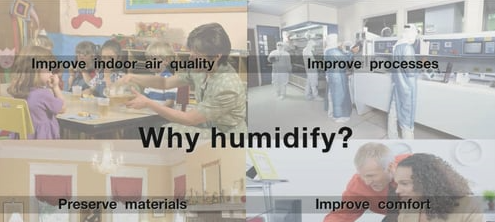Humidification is one of those areas where the terminology can often be a roadblock to understanding the topic. After all, we’re not all meteorologists! Since the terminology can be confusing, we’ve compiled the list of humidification terms below to help you through this series. We’ll link back to this page frequently as we reference these terms in upcoming blogs. You may even want to bookmark it as a handy reference!
Humidification Terms
Humidity: The moisture that is present in the air at any given time. This moisture is actually invisible, as it’s in a gaseous state. The higher the humidity, the greater chance of precipitation, dew, fog, or condensation.
Absolute Humidity, Humidity Ratio, and Specific Humidity: These terms are used interchangeably to describe the same thing, which is the mass of water vapor contained in one pound of air under a given set of circumstances. This value is often expressed in “grains” of water per pound of air (7000 grains equals 1 pound). Expressed as a fraction of a pound, the number would be too small for practical use.
Relative Humidity: This is one of the humidification terms we hear often on the news. The amount of moisture in the air relative to the total amount the air can hold at a given temperature (its saturation point). Warm air can hold more moisture than cold air, so as the temperature changes, so does the relative humidity. If we’re talking about the weather and our local meteorologist tells us to expect 100% humidity, grab your umbrella. It’s going to rain.
Duct Equivalent Relative Humidity: This is the relative humidity air in a duct at a given temperature, as compared to the relative humidity in the space being served at a different temperature. For example, a 55°F duct air stream has a “duct equivalent” relative humidity of 80% when compared to a room condition of 72°F and 45% relative humidity. This information must be known in order to evaluate the absorption distance of the duct.
Dew Point: This is the temperature at which the air cannot hold any more moisture and the moisture begins to condense into water, which may pour out of the sky, bead up on your iced tea glass, or collect and drip from an uninsulated cold water pipe.
Dry Bulb Temperature: When someone asks, “What’s the current temperature?” dry bulb temperature is what they’re referring to. Technically, it’s the temperature of the air as measured by a thermometer that is shielded from radiation and moisture.
Wet Bulb Temperature: The lowest temperature achievable solely by evaporating water into the air. We all know that evaporation of liquid results in cooling – whether it occurs a result of a mechanical application (i.e., evaporative cooling) or the evaporation of sweat from our bodies. Wet bulb temperature is measured with a thermometer that has its bulb wrapped in wetted cloth—called a sock. When exposed to a steady stream of air, the moisture will evaporate and the thermometer reading will drop. When it gets to its lowest point, that’s the current wet bulb temperature.
Sensible Heat: The energy required to change the temperature of a substance. Unlike latent heat, it doesn’t involve any phase change, i.e. water to steam, steam to water.
Latent Heat: The amount of energy that is naturally released or absorbed when liquid is changed to gas or gas to liquid. At sea level, it takes approximately 970 BTUs to change one pound of water into one pound of steam at sea level.
Specific Heat: The amount of heat, in BTUs, required to raise the temperature of one pound of a substance by one degree Fahrenheit. Water has a specific heat of 1.0, so it takes 1 BTU to raise the temperature of a single pound of water by one degree.
Adiabatic Humidification: Adiabatic humidification involves a process in which a temperature change occurs without the addition or removal of heat. Evaporative cooling is one example of an adiabatic process in which a fan draws warm air through moistened pads to facilitate evaporation. As evaporation occurs, air is cooled and pushed into a space, taking with it additional moisture. Thus, adiabatic can be used for both cooling and humidification, depending on the climate. The rate of air flow controls the amount of evaporation in adiabatic processes.
Isothermal Humidification: Isothermal processes are used to introduce moisture into the air without resulting in a temperature change. Rather, water vapor is dispersed into the air after having been created by boiling water. Unlike adiabatic humidification, isothermal humidification does require an external energy source to change the state of the water. Energy consumed from an external energy source to achieve isothermal humidification is approximately 1,000 BTU/LB of moisture.
Vapor Migration: Water vapor behaves like any other low-pressure gas, which means that in a mixture of water vapor and dry air, the water vapor will always migrate from a high vapor pressure area to a lower vapor pressure area. This migration occurs regardless of air movement, unless the air movement is in the same direction, in which case the vapor migration would be accelerated.
Humidification terms is not the most exciting topic but this blog can be used as a reference for future articles.
Catch up on the series:
Part One: Humidification Basics: Why We Humidify in Building Design
Part Three: Psychrometrics Made Easy: Humidification Basics Part 3


